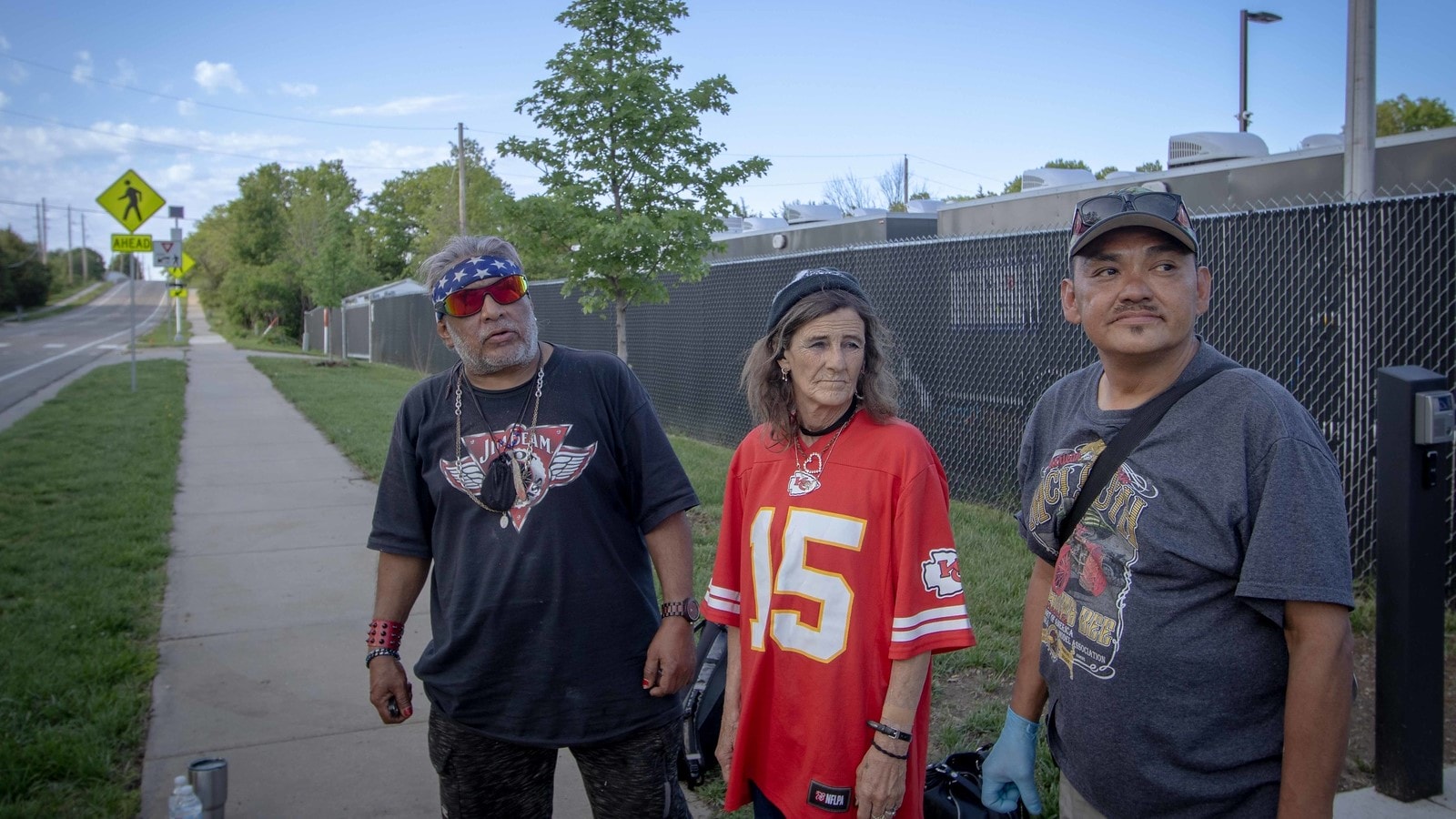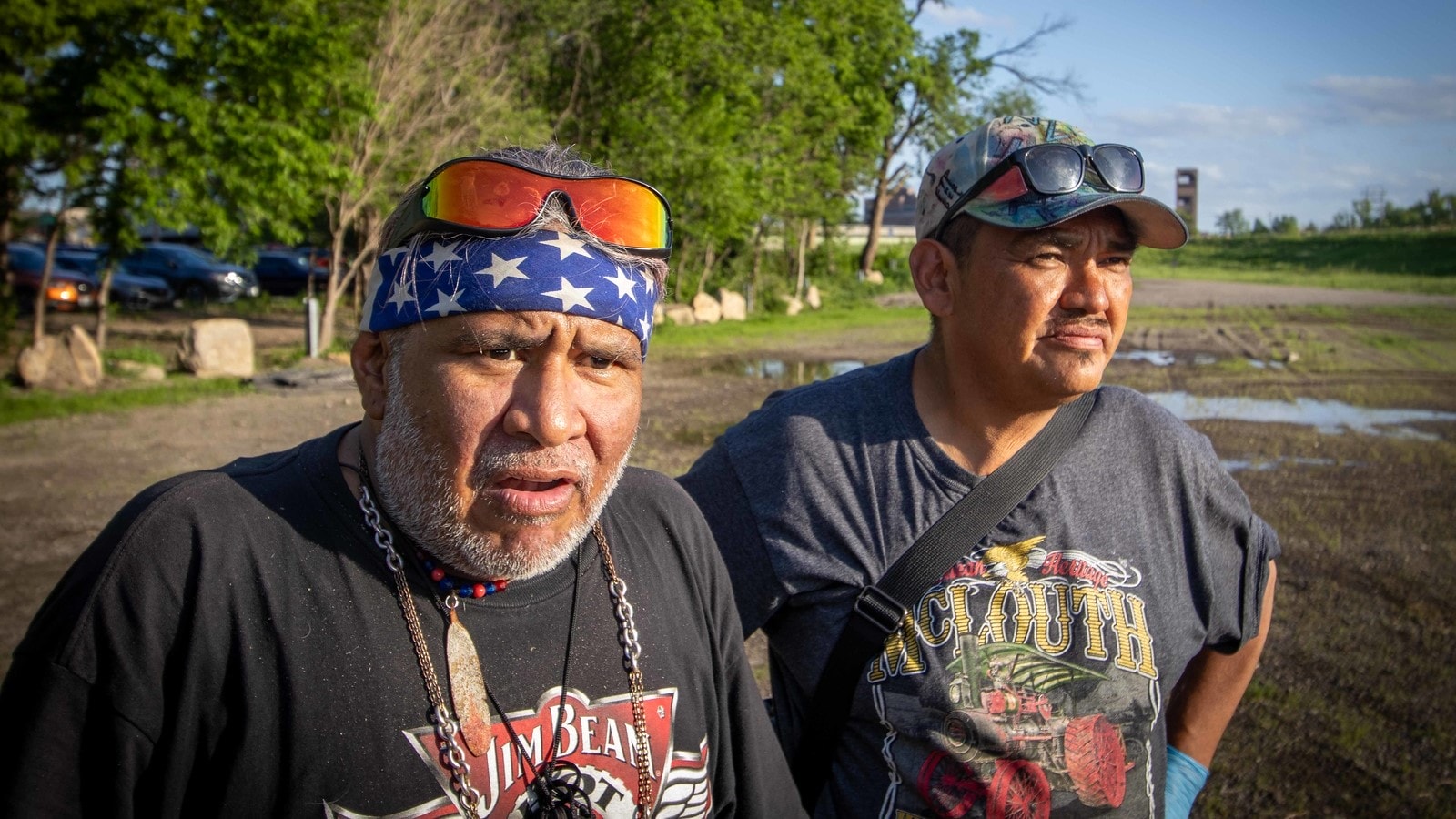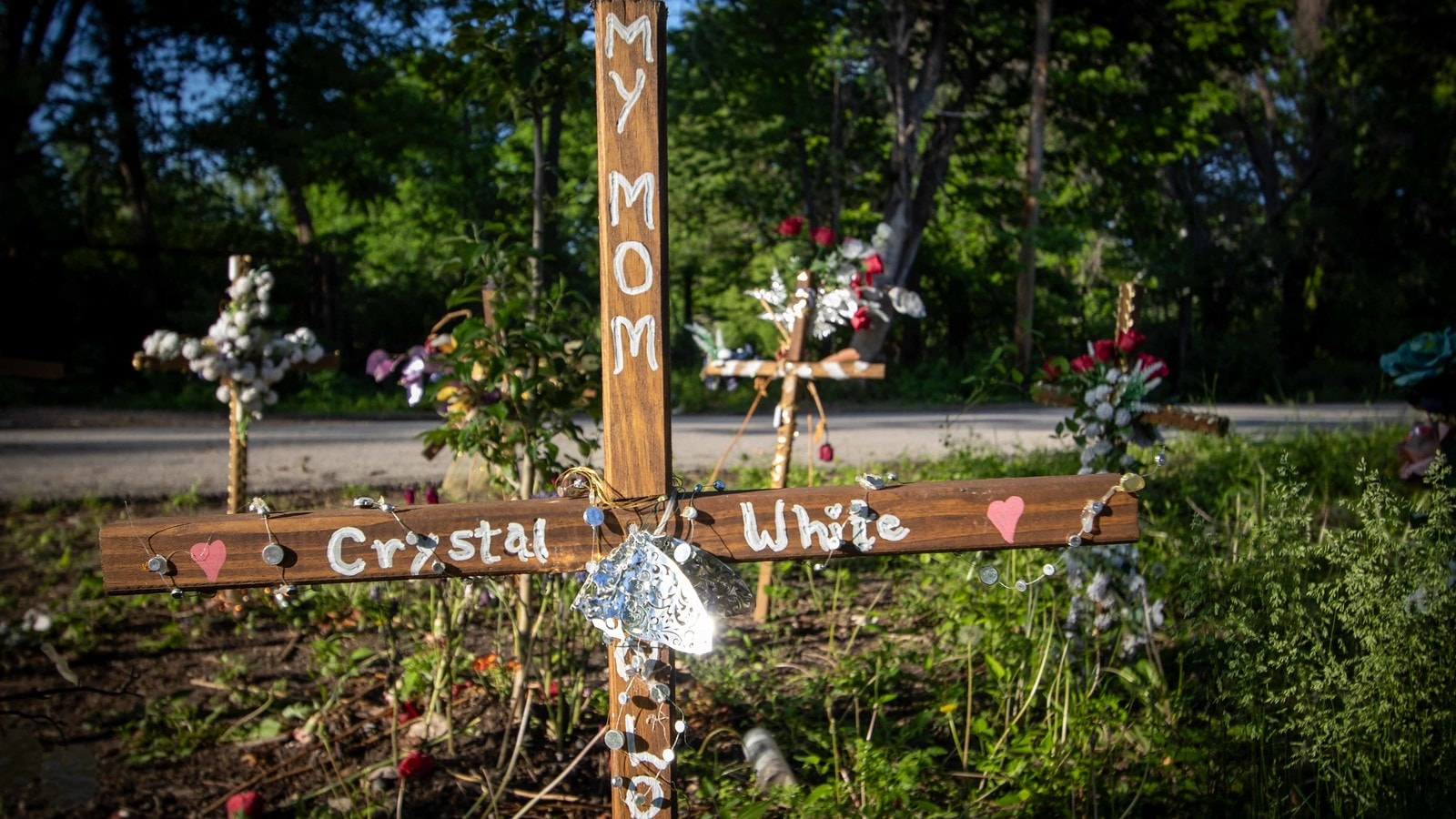As Homelessness Surges, Kansas Communities Look to Lawrence Lawrence has invested in its shelter, temporary housing and services. But has that made it a de facto drop-off site for neighboring law enforcement agencies and service organizations?
Published May 2nd, 2024 at 6:00 AM
Above image credit: Facing north on Vermont Street, just south of the Lawrence Public Library. (Haines Eason | Flatland)LAWRENCE — This college town opened the 50-unit Pallet Shelter Village on March 18 to address a burgeoning number of unhoused people.
Six weeks later, the village is already nearing capacity. There’s also, according to Pallet Village Shelter Manager Juniper Gapetz, “a very long waiting list.”
Chalk it up, in part, to the soaring number of unhoused people, both here in Kansas and across the country.
“(Homelessness) is growing more than I’ve ever seen, and I’ve been in this field for 30 years,” says Kansas Statewide Homeless Coalition (KSHC) Executive Director Christy McMurphy.
McMurphy and her team recently developed a new dashboard for data collection and analysis, one that compiles information from 101 mostly rural Kansas counties, including Douglas County. The dashboard excludes Wichita/Sedgwick County, Topeka/Shawnee County, Johnson County and Kansas City/Wyandotte County.
According to KSHC data, from January to the end of March, 618 newly identified individuals were actively experiencing homelessness just in Kansas’ rural counties.
“That’s brand new. Never been homeless. Never been in our system. Never anything,” says Shanae Eggert, director of the Homeless Management Information System and Coordinated Entry for the Kansas Balance of State Continuum of Care as an employee of the Kansas Statewide Homeless Coalition.
“So, we have 618 people statewide that became homeless for the first time. And with that number, you can say: ‘Can our crisis response system keep up with that number? Are we going to get 600 new housing vouchers in just three months to combat that high inflow number?’ And that answer is no.”
Kansas isn’t alone.
The National Alliance to End Homelessness reported that in 2022 “counts of individuals (421,392 people) and chronically homeless individuals (127,768) reached record highs in the history of data collection.”
And according to the Department of Housing and Urban Development (HUD), 2023 was even worse. HUD released its “2023 Annual Homeless Assessment Report: Part 1: Point-in-Time Estimates” in December, which found a 12% increase in the homelessness population from 2022.
“Our system is designed to respond to homelessness,” Eggert says. “It’s not designed to prevent it. It falls on the federal government, the state, the city, the counties to actually fund the programs that are going to prevent homelessness.
Lawrence is widely considered to be particularly proactive in dealing with homelessness. The city opened its pallet village before closing a city-sanctioned camp in April.
Some say such steps, though, have also made Lawrence a tempting place to “dump” unhoused people from surrounding areas.

Lawrence: Kansas’ Leader on Homelessness
According to at least one expert on homelessness in Kansas, Lawrence is doing a lot of things right.
“We have been to Lawrence to see how they do things because we know they’re on the leading edge of homelessness in the state,” says Myranda Agnew, executive director of Leavenworth’s Community of Hope, a homeless shelter and supportive services provider in operation in various forms since 2014.
“Everything Lawrence does is data-driven, structured, strategic. ‘Okay, now let’s go do it.’ So, we’ve modeled a lot after them. And I presume they deal with a lot more of — dumps are what we call them.”
By “dumps,” Agnew is referring to when an arresting officer, a discharging mental health organization or other party that is legally responsible will release an individual into an environment where they can’t be adequately supported.
According to several sources, what should happen is something called a “warm hand-off.”
A successful warm hand-off involves the authority responsible for a person who is to be transferred, if the person in custody is stable, delivering that person to a shelter or similar facility that can address their basic needs and offer some support services as that person tries to reintegrate into society.
According to Agnew, her view of Lawrence is not isolated, and she believes that individuals experiencing homelessness and other crises could view Lawrence as a place to go for help.
“I have no doubt people go to Lawrence because it has resources,” Agnew says. “I mean, not nearly as many as they need for hundreds of people. But I could see that being way more of a big deal there than here.”
“We have a lot of prisons and jails in town, so we struggle more getting that population discharged here even though they weren’t from here,” Agnew says of the situation in Leavenworth. “Or, I get arrested on the turnpike, I go to jail, I get discharged from jail to the streets, but I really just want to get home to Wichita.”
Can a Town That’s Invests in Essential Services Become a Destination?
Agnew’s assertions raise the question: Has Lawrence become something of a magnet for folks experiencing homelessness?
“I wouldn’t call it a destination. We do have resources here, and I think that has led other people in other communities to feel like we’re better resourced,” says Lawrence Police Department Chief Rich Lockhart. “I know of some instances where other law enforcement agencies have transported folks here.”
One event stands out.
In an August 2023 article published in the Lawrence Journal-World, Lockhart recounts an incident involving a woman originally arrested in Anderson County, Kansas. The woman was walking naked along a road outside of the town of Garnett. Picked up by the Anderson County Sheriff’s Department, the woman was then transported to Lawrence and dropped at the public library.
Within 30 minutes, she was naked again and was re-arrested.
Douglas County Sheriff Jay Armbrister says that such inter-county or -municipality drop-offs approach being a regular event.
“I would say in the last 30 to 60 days, we’ve had probably four people dropped off on the south end of our county where (U.S.) 59 meets Franklin County,” he notes.
He means literally where the highway and the county line intersect — a point almost 13 miles from the extreme south end of Lawrence. It’s also a point where there are no services and where there is no shelter — not even a gas station.

“But I would say most of the drop-off points are here in town,” he continues, adding “most of it occurs coming off the interstate off in the north end by the Burger King and the old mall.”
When asked if it is safe to estimate that 50 to 100 individuals are being transported into Lawrence each year, Lawrence’s Director of Homeless Solutions Division Misty Bosch-Hastings says, “that sounds about right.”
But she adds caveats.
“We’re not really going to know, because it’s all over the place,” she says. “It’s landing on different agencies. But I have been trying to start a coalition of different providers. We had a first meeting, but that would be one of my subgroups is to try to identify what to do about those individuals and come up with some plans.”
For Bosch-Hastings and the city of Lawrence, the municipally sanctioned homeless camp, which the city cleared on April 15, was a loophole that needed to be closed.
“The camp that was open here was the perfect answer because you didn’t have to do a warm hand-off,” Bosch-Hastings said.
“So, in my mind, I used to work in that area, and you can’t discharge to homelessness,” she adds. “I think that they were, and prisons and jails also, they just knew that if they sent them to that camp that they would be given a tent and resources. I think that’s probably what the organizations were doing” and considering it a discharge plan.

Bosch-Hastings says that in the new contract that she and the city established with the Lawrence Community Shelter, Douglas County residents are prioritized.
“If somebody from out of town shows up, we’ll give them three days and then we’ll do a warm hand-off back to their community. So, we’ve been building those safeguards in there to try to deter. And now with the sanctioned camp closed, I think that’s going to help us get ahead of it.”
There is a clear need to get ahead of the issue when looking at point-in-time homelessness survey numbers.
Official and unofficial numbers show a notable increase in the number of unhoused individuals living outdoors within the Lawrence community.
According to Bosch-Hastings, HUD’s 2023 point-in-time survey found 351 homeless individuals in Lawrence.
“Now, they were counted homeless,” Bosch-Hastings says. “But that means in transitional beds, in the emergency shelter and outside. So, of that 351, only 95 were outside.”
When asked about 2024’s survey, which is still unofficial until HUD approves it, Bosch-Hastings says the outside count was 140, a nearly 50% increase.
It All Comes Down to Housing
Lawrence didn’t close its sanctioned camp in April without a solution in the works. The closure was preceded by the opening of the Pallet Shelter Village at 256 N. Michigan St. on March 18.
However, the pallet village already is close to capacity with 48 guests and two scheduled to move in.
Bosch-Hastings and Lockhart note that, while not everyone in the sanctioned camp chose to transition to the village, those who were willing and able were moved.
As for who is prioritized for residence at the Pallet Shelter Village, manager Gapetz says that list includes veterans, individuals aged 55 and older, domestic abuse survivors and the disabled. After these groups, the next priority is the chronically homeless. The Pallet Shelter Village can’t accommodate children or individuals needing home health support.
Gapetz says the basic plan for new residents is to have them “chill for a few weeks and get their feet under them.” Then, she says, residents are connected with an on-site case manager and services.
The goal?
“We want to get folks housed in three to six months as long as they’re actively engaging with us, and we’re not sure yet what happens after six months,” Gapetz says.
Bosch-Hastings, Gapetz and newly hired Lawrence Community Shelter Executive Director James Chiselom all underscored that the Pallet Shelter Village is just one piece of the city’s effort to support individuals experiencing homelessness.
In addition to the 50 units at the Pallet Shelter Village and the city’s 95-bed overnight shelter — Lawrence Community Shelter (LCS) on East 25th Street — the city is working to open a 65-bed family shelter (there is no timeline as of yet) and also has a 90-day, 30-seat transition-to-housing program in place at LCS.
But the city is not working on homelessness alone. It has longstanding relationships with several organizations, notably The Bert Nash Community Mental Health Center.
The city and Bert Nash have partnered in at least one critical area regarding homelessness. Since 2006, Bert Nash has operated a Homeless Outreach Team that provides “services to those community members to support them as they obtain their desired level of independence.”
From a Village to a Home
Jason Kuhn and Renea Sharp are among the Pallet Shelter Village’s first tenants. As the first moved in, they are also leaders when it comes to providing the city with an understanding of how the residents are adjusting to life in the village so far.
And, according to the two of them, both former residents of the city’s sanctioned tent camp, life so far has been much calmer.
“It’s been pretty quiet, unlike camp. Camp was pretty crazy. A lot of overdoses. Death,” Sharp says. “Murder, a few deaths, but one of them was a murder.”

Kuhn and Sharp say the pallet village is doing a good job of meeting residents’ basic needs. The pallet units are heated and cooled, and laundry, bathing and kitchen facilities are available. There’s even Wi-Fi and a common area, and residents can come and go as they please outside of curfew (10 p.m. to 7 a.m.).
And, unlike overnight shelters, the village is meant to provide a stable place over time for residents to live and regain their footing. Each unit is for the use of its assigned resident and remains so until the resident transitions to a new housing arrangement.
Kuhn and Sharp’s only real complaint about the village itself is that they are unable to have their dog Athena with them.
“There’s a lot of people that are homeless that have pets, and they won’t come here because there’s no pets allowed, or they won’t go to the shelter because the shelter allows you to bring your pet, but you have to kennel it,” Sharp says.
Kuhn adds that for Sharp, “Athena is her protector. When I was gone in jail, Athena was there to make sure that nobody messing with her when I wasn’t around.”
As for how Kuhn and Sharp came to Lawrence, they say they came here independently, with him arriving around 1998 and her in 2009.
Kuhn is originally from Chicago, and Sharp from Kansas City. The two connected in Lawrence in the summer of 2022, living with friends or in a car or on the streets since that time. Kuhn was incarcerated in July 2023 for seven months. Now, the two hope to move to Topeka from the village to be closer to the Veterans Administration offices there. Kuhn is a veteran.
When asked what they want people to know about the experience of homelessness, Sharp just wished people would “open their mind.”
“Anybody can become homeless at any point in time,” she says. “And everybody looks at homeless people like they’re terrible, horrible people. But they don’t know everyone’s story. They just assume that all the break-ins or all the crime rate is from a homeless person.”
“None of us woke up one morning and said, ‘Oh, I think I’m just going to be homeless from now on,’” Kuhn adds. “I think people need to again look at people on a case-by-case basis. We’re not all the same.”

Flatland contributor Haines Eason is the owner of startup media agency Freelance Kansas.


